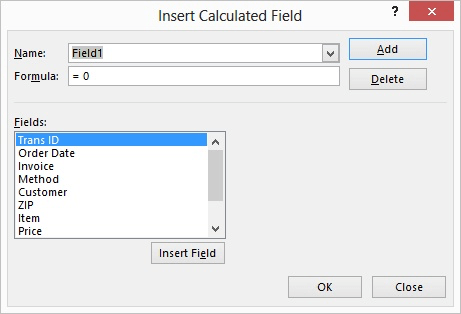Please Note: This article is written for users of the following Microsoft Excel versions: 2007, 2010, 2013, and 2016. If you are using an earlier version (Excel 2003 or earlier), this tip may not work for you. For a version of this tip written specifically for earlier versions of Excel, click here: Weighted Averages in a PivotTable.
Written by Allen Wyatt (last updated April 29, 2021)
This tip applies to Excel 2007, 2010, 2013, and 2016
A good example of how to use calculated fields is for summarizing data differently than you can normally summarize it with a PivotTable. When you create a PivotTable, you can use several different functions to summarize the data that is displayed. For instance, you can create an average of data in a particular field. What if you want to create a weighted average, however? Excel doesn't provide a function that automatically allows you to do this.
When you have special needs for summations—like weighted averages—the easiest way to achieve your goal is to add an additional column in the source data as an intermediate calculation, and then add a calculated field to the actual PivotTable.
For example, you could add a "WeightedValue" column to your source data. The formula in the column should multiply the weight times the value to be weighted. This means that if your weight is in column C and your value to be weighted is in column D, your formula in the WeightedValue column would simply be like =C2*D2. This formula will be copied down the entire column for all the rows of the data.
You are now ready to create your PivotTable, which you should do as normal with one exception: you need to create a Calculated Field. Follow these steps:

Figure 1. The Insert Calculated Field dialog box.
Your calculated field is now inserted, and you can use the regular summation functions to display a sum of the calculated field; this is your weighted average.
Since there are many different ways that weighted averages can be calculated, it should go without saying that you can modify the formulas and steps presented here to reflect exactly what you need done with your data.
ExcelTips is your source for cost-effective Microsoft Excel training. This tip (7129) applies to Microsoft Excel 2007, 2010, 2013, and 2016. You can find a version of this tip for the older menu interface of Excel here: Weighted Averages in a PivotTable.

Professional Development Guidance! Four world-class developers offer start-to-finish guidance for building powerful, robust, and secure applications with Excel. The authors show how to consistently make the right design decisions and make the most of Excel's powerful features. Check out Professional Excel Development today!
Are you attached to the classic PivotTable layout? Looking for a way to make that layout the default for new PivotTables? ...
Discover MoreIf you ever try to edit a PivotTable and get an error that tells you that the "underlying data was not included," it can ...
Discover MorePivotTables are used to analyze huge amounts of data. The number of rows used in a PivotTable depends on the type of ...
Discover MoreFREE SERVICE: Get tips like this every week in ExcelTips, a free productivity newsletter. Enter your address and click "Subscribe."
2017-07-18 14:53:46
Gary
This tip would be much more helpful if specific examples were included. A selection of cells with headings and values and/or formulas could be shown from the original worksheet and another selection of cells from the pivot table could be shown. Thank you.
2017-07-18 03:00:00
Lars
"In the Formula box, enter the formula you want used for your weighted average, such as =WeightedValue/Weight", that brings me back to the original Value?
Or have I missed something?
Got a version of Excel that uses the ribbon interface (Excel 2007 or later)? This site is for you! If you use an earlier version of Excel, visit our ExcelTips site focusing on the menu interface.
FREE SERVICE: Get tips like this every week in ExcelTips, a free productivity newsletter. Enter your address and click "Subscribe."
Copyright © 2025 Sharon Parq Associates, Inc.
Comments